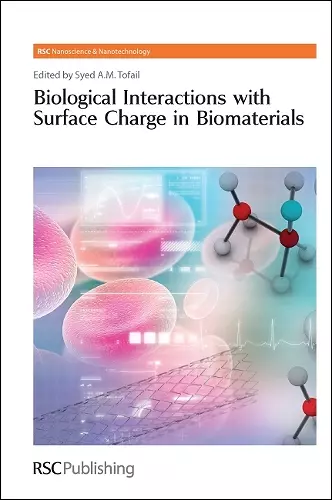Biological Interactions with Surface Charge in Biomaterials
Format:Hardback
Publisher:Royal Society of Chemistry
Published:14th Nov '11
Currently unavailable, and unfortunately no date known when it will be back

When a biomaterial is placed inside the body, a biological response is triggered almost instantaneously. With devices that need to remain in the body for long periods, such interactions can cause encrustation, plaque formation and aseptic loosening on the surface. These problems contribute to the patient's trauma and increase the risk of death. Electrical properties, such as local electrostatic charge distribution, play a significant role in defining biological interactions, although this is often masked by other factors. This book describes the fundamental principles of this phenomenon before providing a more detailed scientific background. It covers the development of the relevant technologies and their applications in therapeutic devices such as MRSA-resistant fabrics, cardiovascular and urological stents, orthopaedic implants, and grafts. Academic and graduate students interested in producing a selective biological response at the surface of a given biomaterial will find the detailed coverage of interactions at the nanometre scale useful. Practitioners will also benefit from guidance on how to pre-screen many inappropriate designs of biomedical devices long before any expensive, animal or potentially risky clinical trials. Enhanced by the use of case studies, the book is divided in to four topical sections. The final section is dedicated to the application of related topics making the book unique in its pragmatic approach to combining high end interdisciplinary scientific knowledge with commercially viable new technologies. Contributing to the newly emerging discipline of 'nanomedicine', the book is written not only by experts from each relevant specialty but also by practitioners such as clinicians and device engineers from industry.
The book originates from the activity of a BioElectricSurface consortium, funded by the European Commission under the FP-7 Nanosciences, Nanotechnologies, Materials and New Production Technologies (NMP) program and discusses the crucial role surface charge plays in the interaction between materials in biological and medical applications. The first part of the book covers new findings in biology, e.g. bone growth by charged hydroxyapatite and photocatalytic effect in doped titania and includes useful explanations of the many modern techniques used to create and measure electric charges at surfaces and intersurfaces. The first part of the book contains some very useful information, such as discussion of the polarization of hydroxyapatite, which increased bone growth on the negative surface while no growth was observed on the positive surface, and commentary on the increased photocatalytic activity of doped titania . This section also concisely, but thoroughly, analyses thermally stimulated depolarization current methods, the laser intensity modulation method of charge measurements, scanning probe, Kelvin probe force and electrostatic force microscopy, and the streaming potential measurement techniques used for wet cases. The techniques utilized for interfacial measurements, such as confocal laser scanning microscopy, are also covered in chapter 4. Part 2 describes many practical examples in which the surface interactions play an essential role. For example, chapter 5 discusses immobilized enzymes on porous surfaces in biocatalysts, drug delivery, and biosensors, while chapter 6 goes on to describe improvement of the extracellular matrix (ECM) by the interactions of host tissue cells with the implant surface Chapters 7, 8 and 9 discuss antibody immobilization on solid surfaces, adhesion, proliferation and differentiation of bone-forming cells with electrostatic charge at biomaterials surfaces and interactions of biofilm-forming bacteria with abiotic surfaces. Endothelial cells and smooth muscle cells on the biomaterials surfaces, interactions of bacteria and fungi on biofilms in hospital acquired infections and immunological response of electrostatic charge at the surface of biomaterials are covered in chapters 10, 11 and 12. Such elaborate discussions show the relevance of surface charge in biological interactions at and with non-biological surfaces and, I strongly believe, will provide a solid foundation for interested readers who are willing to bring innovative ideas of surface modifications to generate or control a specific biological response on implantable therapeutic devices. Part 3 of the book is a logical progression from parts 1 and 2, and describes some of the important applications where surface charge is believed to play a significant role. These include: Community and hospital acquired infections of methicillin-resistant staphylococcus aureus (MRSA), MRSA-resistant textiles, inhibition of encrustation in urological devices and the reduction of restenosis in cardiovascular stents. The book finishes with a general overview of a new class of materials, named as vector materials, where the interfaces between biomaterial and biological environment can be manipulated by the application of vectorial effects induced by electrical polarization. Surface charges are frequently experienced by the frictional electricity in textiles. The infection of bacteria and the restenosis of implanted stenosis are broadly concerned matters in the society. As a basic research, it is noteworthy that negatively charged hydroxyapatite induces new bone. The book shows that the study of electric charge in surfaces is important to understand the basic mechanism of all these matters. The many topics introduced in this book promises more rapid progress in future research. The abbreviation of technical words sometime hinders the understanding of sentences, but the subject index at the end of the book helps greatly to solve this difficulty. The arrangement of chapters is also well ordered. The Editor’s kind efforts are appreciated. -- Eiichi Fukada, Kobayasi Institute of Physical Research, Tokyo, Japan and Emeritus Scientist, RIKEN, Wako, Japan
ISBN: 9781849731850
Dimensions: unknown
Weight: 564g
276 pages